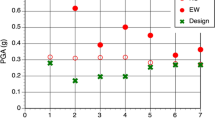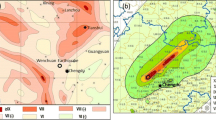Abstract
Seismic hazard and risk are two very important concepts in engineering design and other policy considerations. Although seismic hazard and risk have often been used interchangeably, they are fundamentally different. Furthermore, seismic risk is more important in engineering design and other policy considerations. Seismic hazard assessment is an effort by earth scientists to quantify seismic hazard and its associated uncertainty in time and space and to provide seismic hazard estimates for seismic risk assessment and other applications. Although seismic hazard assessment is more a scientific issue, it deserves special attention because of its significant implication to society. Two approaches, probabilistic seismic hazard analysis (PSHA) and deterministic seismic hazard analysis (DSHA), are commonly used for seismic hazard assessment. Although PSHA has been proclaimed as the best approach for seismic hazard assessment, it is scientifically flawed (i.e., the physics and mathematics that PSHA is based on are not valid). Use of PSHA could lead to either unsafe or overly conservative engineering design or public policy, each of which has dire consequences to society. On the other hand, DSHA is a viable approach for seismic hazard assessment even though it has been labeled as unreliable. The biggest drawback of DSHA is that the temporal characteristics (i.e., earthquake frequency of occurrence and the associated uncertainty) are often neglected. An alternative, seismic hazard analysis (SHA), utilizes earthquake science and statistics directly and provides a seismic hazard estimate that can be readily used for seismic risk assessment and other applications.






Similar content being viewed by others
References
Abrahamson, N. A. and Bommer, J. J. (2005), Probability and uncertainty in seismic hazard analysis, Earthq Spectra 21, 603–607
Abrahamson, N. A. and Silva, W. J. (1997), Empirical response spectral attenuation relations for shallow crustal earthquake, Seism Res Lett 68, 94–108
Abrahamson, N. A. and Silva, W. J. (2008), Summary of the Abrahamson and Silva NGA ground motion relations, Earthq Spectra 24, 67–97
Anderson, G. A. and Brune, J. N. (1999), Probabilistic seismic hazard analysis without the ergodic assumption, Seism Res Lett 70, 19–28
Atkinson, G. M. and Boore, D. M. (2006), Earthquake ground-motion prediction equations for eastern North America, Bull Seismol Soc Am 96, 2181–2205
Bakun, W. H. and Hopper, M. G. (2004), Historical seismic activity in the central United States, Seism Res Lett 75, 564–574
Bazzurro, P. and Cornell, C. A. (1999), Disaggregation of seismic hazard, Bull Seismol Soc Am 89, 501–520
Benjamin, J. R., Cornell, C. A. (1970), Probability, statistics, and decision for civil engineers, New York, McGraw-Hill Book Company, 684 p
Bommer, J. J. (2003), Uncertainty about the uncertainty in seismic hazard analysis, Eng Geol 70, 165–168
Bommer, J. J. and Abrahamson, N. A. (2006), Why do modern probabilistic seismic-hazard analyses often lead to increased hazard estimates? Bull Seismol Soc Am 96, 1976–1977
Bommer, J. J., Abrahamson, N. A., Strasser, F. O., Pecker, A., Bard, P.-Y., Bungum, H., Cotton, F., Fäh, D., Sabetta, F., Scherbaum, F., and Studer, J. (2004), The challenge of defining upper bounds on earthquake ground motions, Seism Res Lett 75, 82–95
Boore, D. M., Joyner, W. B., and Fumal, T. E. (1997), Equations for estimating horizontal response spectra and peak acceleration from western North American earthquakes: A summary of recent work, Seism Res Lett 68,128–153
Building Seismic Safety Council (BSSC). (1998), NEHRP recommended provisions for seismic regulations for new buildings [1997 ed.], Federal Emergency Management Agency, FEMA, 302, 337 pp
Campbell, K. W. (1981), Near-source attenuation of peak horizontal acceleration, Bull Seismol Soc Am 71, 2039–2070
Campbell, K. W. (2003), Prediction of strong ground motion using the hybrid empirical method and its use in the development of ground-motion (attenuation) relations in eastern North America, Bull Seismol Soc Am 93, 1012–1033
Cornell, C. A. (1968), Engineering seismic risk analysis, Bull Seismol Soc Am 58, 1583–1606
Cornell, C. A. (1971), Probabilistic analysis of damage to structures under seismic loads. In Dynamic Waves in Civil Engineering (eds. Howells, D. A., Haigh, I. P., and Taylor, C.), Proceedings of a Conference Organized by the Society for Earthquake and Civil Engineering Dynamics (John Wiley, New York)
Frankel, A., Mueller, C., Barnhard, T., Leyendecker, E.V., Wesson, R. L., Hanson, S., Klein, F. W., Perkins, D. E., Dickman, N., and Hopper, M. (2000), USGS national seismic hazard maps, Earthq Spectra 16, 1–19
Frankel, A., Petersen, M., Mueller, C., Haller, K., Wheeler, R., Leyendecker, E., Wesson, R., Harmsen, S., Cramer, C., Perkins, D., and Rukstales, K. (2002), Documentation for the 2002 update of the national seismic hazard maps, U.S. Geological Survey Open-File Report 02-420, 33 pp
Frankel, A., Mueller, C., Barnhard, T., Perkins, D., Leyendecker, E., Dickman, N., Hanson, S., and Hopper, M. (1996), National seismic hazard maps: Documentation June 1996, U.S. Geological Survey Open-File Report 96-532, 110 pp
Gupta, R. S., Hydrology and Hydraulic Systems (Prentice Hall, Englewood Cliffs, N.J., 1989), 739 pp
International Code Council (ICC). (2006), International Building Bode (International Code Council Inc.)
Kircher, C. A., Luco, N., and Whittaker, A. (2008), Summary of SDPRG proposal for changes to the 2009 NEHRP provisions, Building Seismic Safety Council Seismic Design Procedures Reassessment Group (SDPRG) workshop, September 10, 2008, Burlingame, California
Kircher, C. A., Seligson, H. A., Bouabid, J., and Morrow, G. C. (2006), When the Big One strikes again—Estimated losses due to a repeat of the 1906 San Francisco earthquake. In Proceedings of the 8th National Conference on Earthquake Engineering, April 18–22, 2006, San Francisco, CA
Klügel, J.-U. (2005), Problems in the application of the SSHAC probability method or assessing earthquake hazards at Swiss nuclear power plants, Eng Geol 78, 285–307
Klügel, J.-U., Mualchin, L., and Panza, G. F. (2006), A scenario-based procedure for seismic risk analysis, Eng Geol 88, 1–22
Krinitzsky, E. L. (1993a), Earthquake probability in engineering—Part 1: The use and misuse of expert opinion, Eng Geol 33, 257–288
Krinitzsky, E. L. (1993b), Earthquake probability in engineering—Part 2: Earthquake recurrence and limitations of Gutenburg-Richter b-values for the engineering of critical structures, Eng Geol 36, 1–52
Krinitzsky, E. L. (1995), Deterministic versus probabilistic seismic hazard analysis for critical structures, Eng Geol 40, 1–7
Krinitzsky, E. L. (2002), How to obtain earthquake ground motions for engineering design, Eng Geol 65, 1–16
Leyendecker, E. V., Hunt, R. J., Frankel, A. D., and Rukstales, K. S. (2000), Development of maximum considered earthquake ground motion maps, Earthq Spectra 16, 21–40
Li, X., Zhou, Z., Huang, M., Wen, R., Yu, H., Lu, D., Zhou, Y., and Cui, J. (2008), Preliminary analysis of strong-motion recordings from the magnitude 8.0 Wenchuan, China, earthquake of 12 May 2008, Seism Res Lett 79, 844–854
Luco, N. (2008), Risk-Targeted Ground Motions: Building Seismic Safety Council Seismic Design Procedures Reassessment Group (SDPRG) workshop, September 10, 2008, Burlingame, CA
Malhotra, P. K. (2008), Seismic design loads from site-specific and aggregate hazard analyses, Bull Seismol Soc Am 98, 1849–1862
McGuire, R. K. (2004), Seismic hazard and risk analysis, Earthquake Engineering Research Institute, MNO-10, 240 pp
McGuire, R. K., Cornell, C. A., and Toro, G. R. (2005), The case for using mean seismic hazard, Earthq Spectra 21, 879–886
Mendenhall, W., Scheaffer, R. L., Wackerly, D. D. (1986), Mathematical statistics with applications, Boston, Duxbury Press, 750 p
Milne, W. G., Davenport, A. G. (1969), Distribution of earthquake risk in Canada, Bull Seismol Soc Am 59, 729–754
Mualchin, L., 1996, Development of the Caltrans deterministic fault and earthquake hazard map of California, Eng Geol 42, 217–222
Musson, R. M. W. (2005), Against fractiles, Earthq Spectra 21, 887–891
Petersen, M. D., Frankel, A. D., Harmsen, S. C., Mueller, C. S., Haller, K. M., Wheeler, R. L., Wesson, R. L., Zeng, Y., Boyd, O. S., Perkins, D. M., Luco, N., Field, E. H., Wills, C. J., and Rukstales, K. S. (2008), Documentation for the 2008 update of the United States national seismic hazard maps, U.S. Geological Survey Open-File Report 08-1128, 60 pp
People’s Republic of China National Standard (PRCNS). (2001), Seismic ground motion parameter zonation map of China, GB 18306-2001, China Standard Press
Reiter, L., Earthquake Hazard Analysis (Columbia University Press, New York, 1990), 254 pp
Sachs, P., Wind Forces In Engineering, 2nd edn. (Pergamon Press Inc., Elmsford, N.Y., 1978), 400 pp
Senior Seismic Hazard Analysis Committee (SSHAC). (1997), Recommendations for probabilistic seismic hazard analysis: Guidance on uncertainty and use of experts, Lawrence Livermore National Laboratory, NUREG/CR-6372, 81 pp
Silva, W., Gregor, N., and Darragh, R. (2002), Development of regional hard rock attenuation relationships for central and eastern North America, Pacific Engineering and Analysis, 311 Pomona Ave., El Cerrito, Calif., 94530, 57 pp
Stein, S., Tomasello, J., and Newman, A. (2003), Should Memphis build for California’s earthquakes? EOS, Trans AGU 84, 177, 184–185
Stepp, J. C., Wong, I., Whitney, J., Quittmeyer, R., Abrahamson, N., Toro, G., Youngs, R., Coppersmith, K., Savy, J., Sullivan, T., and Yucca Mountain PSHA project members. (2001), Probabilistic seismic hazard analysis for ground motions and fault displacements at Yucca Mountain, Nevada, Earthq Spectra 17, 113–151
Strasser, F. O., Abrahamson, N. A., and Bommer, J. J. (2009), Sigma: Issues, insights, and challenges, Seism Res Lett 80, 41–56
U.S. Geological Survey. (2009), Important note on use of new 2008 USGS hazard maps: earthquake.usgs.gov/research/hazmaps/products_data/2008/disclaimer.php. Accessed 9/2/2009
Wang, Z. (2006), Understanding seismic hazard and risk assessments: An example in the New Madrid Seismic Zone of the central United States. In Proceedings of the 8th National Conference on Earthquake Engineering, April 18–22, 2006, San Francisco, Calif., paper 416
Wang, Z. (2007), Seismic hazard and risk assessment in the intraplate environment: The New Madrid Seismic Zone of the central United States. In Continental Intraplate Earthquakes: Science, Hazard, And Policy Issues (eds. Stein, S. and Mazzotti, S.), Geological Society of America Special Paper 425, pp. 363–373
Wang, Z. (2008), Understanding seismic hazard and risk: A gap between engineers and seismologists. In 14th World Conference on Earthquake Engineering, October 12–17, 2008, Beijing, China, Paper S27-001, 11 pp
Wang, Z. (2009a), Comment on “Sigma: Issues, Insights, and Challenges” by Fleur O. Strasser, Norman A. Abrahamson, and Julian J. Bommer, Seismol Res Lett 80, 491–493
Wang, Z. (2009b), Seismic hazard vs. seismic risk, Seismol Res Lett 80, 673–674
Wang, Z. and Ormsbee, L. (2005), Comparison between probabilistic seismic hazard analysis and flood frequency analysis, EOS Trans AGU 86, 45, 51–52
Wang, Z., Woolery, E. W., Shi, B., and Kiefer, J. D. (2003), Communicating with uncertainty: A critical issue with probabilistic seismic hazard analysis, EOS Trans AGU 84, 501, 506, 508
Wang, Z., Woolery, E. W., Shi, B., and Kiefer, J. D. (2004), Reply to Comment on “Communicating with uncertainty: A critical issue with probabilistic seismic hazard analysis” by C.H. Cramer, EOS Trans AGU 85, 283, 286
Wang, Z. and Zhou, M. (2007), Comment on “Why do modern probabilistic seismic-hazard analyses often lead to increased hazard estimates?” by Julian J. Bommer and Norman A. Abrahamson, Bull Seismol Soc Am 97, 2212–2214
Working Group on California Earthquake Probabilities (WGCEP). (2003), Earthquake probabilities in the San Francisco Bay Region: 2002–2031, U.S. Geological Survey Open-File Report 03-214, 235 pp
Xie, F., Wang, Z., Du, Y., and Zhang, X. (2009), Preliminary observations of the faulting and damage pattern of M8.0 Wenchuan, China, earthquake, Prof Geol 46(4), 3–6
Youngs, R. R., Abrahamson, N., Makdisi, F. I., and Sadigh, K. (1995), Magnitude-dependent variance of peak ground acceleration, Bull Seismol Soc Am 85, 1161–1176
Acknowledgments
I thank Meg Smath of the Kentucky Geological Survey for editorial help. I appreciate comments and suggestions from Kelin Wang. I also appreciate the comments and suggestions from Kojiro Irikura and two anonymous reviewers, which help to improve the manuscript greatly.
Author information
Authors and Affiliations
Corresponding author
Rights and permissions
About this article
Cite this article
Wang, Z. Seismic Hazard Assessment: Issues and Alternatives. Pure Appl. Geophys. 168, 11–25 (2011). https://doi.org/10.1007/s00024-010-0148-3
Received:
Revised:
Accepted:
Published:
Issue Date:
DOI: https://doi.org/10.1007/s00024-010-0148-3




